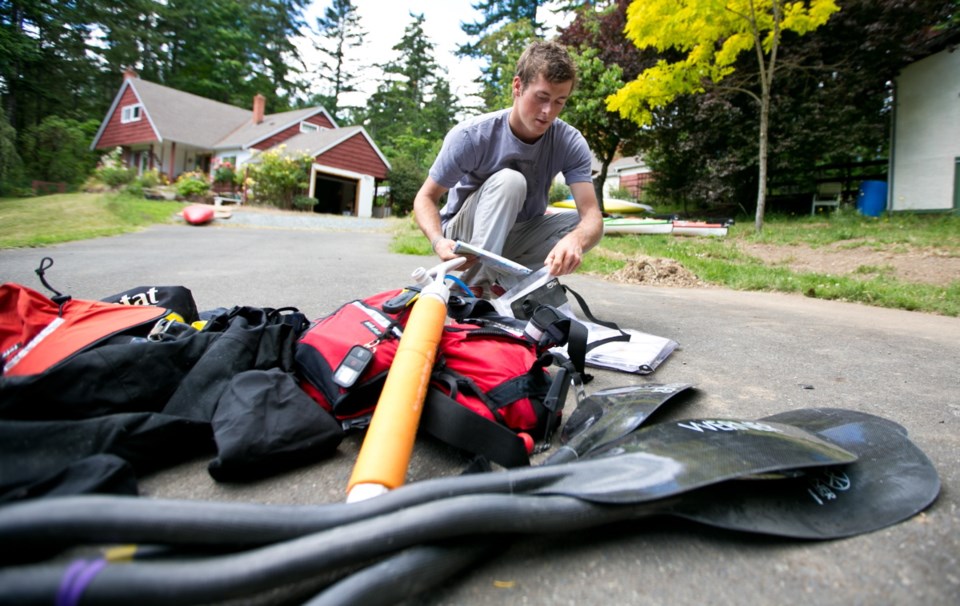The physical toll of becoming the fastest kayaker to circle Vancouver Island is already wearing off for Russell Henry, whose salt sores and blistered hands are healing quickly.
The 22-year-old is relaxing this week after crushing the record for fastest human-powered circumnavigation of the Island, a distance of roughly 1,100 kilometres.
Henry finished the journey in 12 days, 23 hours and 45 minutes, shaving more than 21Ú2 days off the record Colin Angus set in 2011 by rowboat. The fastest sea kayak time was formerly held by Joe O’Blennis, at 16 days, 12 hours and 14 minutes.
What makes someone set out on such a feat?
“I just wanted to see if I could do it,” Henry said.
Henry is developing a habit of setting lofty water-travel goals for himself. Last year, he and his older brother Graham kayaked 6,500 kilometres from Brazil to Florida in seven months.
The Henrys grew up going on kayak trips, thanks to parents who work in the industry — father Brian Henry owns Ocean River Sports. It’s a sport Russell Henry said he’d like to see more young people embrace. “Young people want adrenaline. … So I think [sea kayaking] is thought of as boring,” he said. “But people need to get that out of their minds and start thinking of sea kayaking as hiking on the water. People hike — they’ll do the West Coast Trail to go see cool, remote places. I kayak past all that.”
Henry’s trip began with a change of plans: After announcing on social media that he would depart from Oak Bay’s Willows Beach on May 29, he made a last-minute decision that morning to drive 10 hours to Winter Harbour, on the northwestern tip of the Island. Strong northwesterly winds, blowing at 20 to 40 knots, meant it could be a rough ride paddling north, but starting in the north meant he had those winds at his back. Sunny skies carrying him down the west coast of the Island.
His biggest obstacle was a 45-centimetre crack he caused in the hull of his boat early on by dragging it on shore, which he only noticed the next morning.
“I looked behind me and my back deck was covered in water. When I got out, it felt like I was touching a hot frying pan,” Henry said, closing his eyes and reaching his hand out slowly as if to touch his boat, then quickly retracting it.
“Nooo!”
Duct tape did the trick for a few days, before he read the instructions on the epoxy in his repair kit and realized it didn’t actually need 24 hours to dry.
The days were long — 11 to 14 hours of paddling, for a pace of between 70 and 80 kilometres per day. His hands took the toughest beating, exposed to sun and salt.
“Every night, I’d bring my first aid kid in the tent, I’d pop my blisters, I’d bandage them all up,” he said. “Then halfway through the trip, I started getting blisters underneath blisters. I couldn’t pop those. … The last day starting out, it was so painful.”
Henry also had a birthday by himself. He did not see anyone that day.
He ramped up his pace in the final days because he just wanted the trip to be over.
Is it a trip he’d recommend? Not at the pace he went.
“It was just damn hard. I love pushing myself to the limit and I love doing big days, paddling. Fifty kilometres a day? Sweet,” he said. “But the reason I love it is because when you get off the water, everything is just so good.”
Lying down can be luxurious and campfire dinners taste delicious after a long paddle, he said. But at the record-setting pace, there wasn’t any time for that.
Henry will soon head up to Strathcona Park Lodge to work in outdoor education. But he’s already looking into more long-distance kayak races, as well as planning a blended kayak-ski trip for next spring. It would involve paddling up Bute Inlet from Port McNeill, then climbing to the summit of Mount Waddington.
“My brain is going crazy these days trying to come up with the next trip,” he said.
“But I would also like to kayak around the Island again, with some friends, and take at least a month.”



